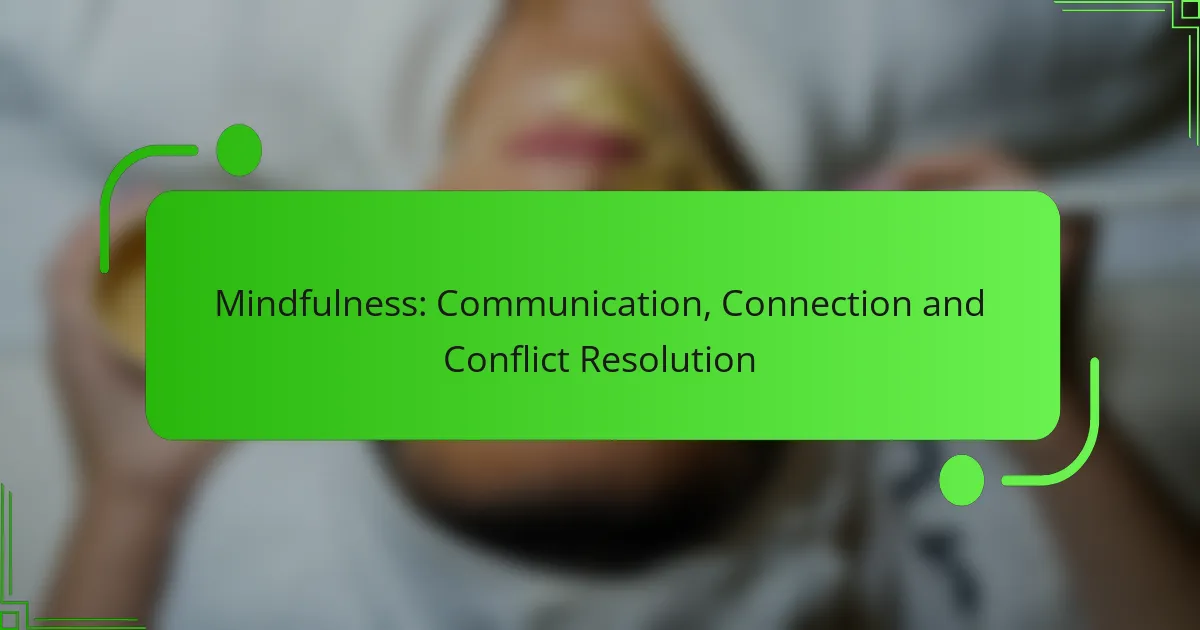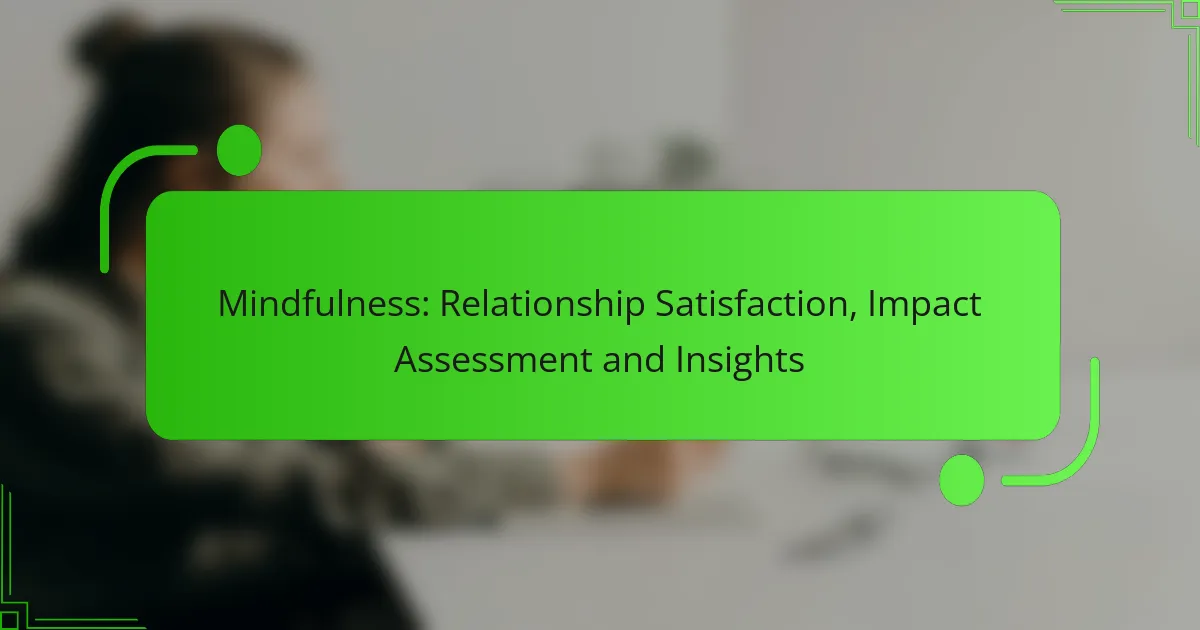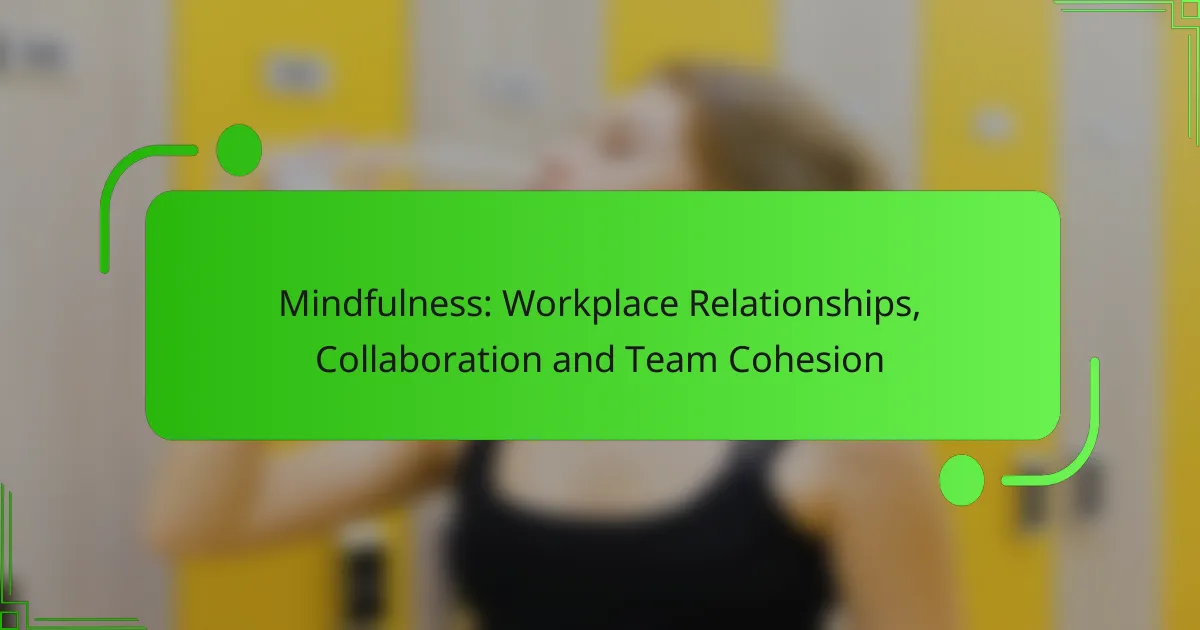Mindfulness plays a crucial role in enhancing communication, connection, and conflict resolution in relationships. By fostering awareness and presence, it allows individuals to engage deeply, listen actively, and respond thoughtfully, ultimately reducing misunderstandings. Furthermore, mindfulness practices promote emotional regulation and self-awareness, enabling more constructive navigation of disagreements and strengthening interpersonal relationships.

How can mindfulness improve communication in relationships?
Mindfulness enhances communication in relationships by fostering awareness and presence during interactions. This practice allows individuals to engage more deeply, listen actively, and respond thoughtfully, reducing misunderstandings and conflicts.
Active listening techniques
Active listening involves fully concentrating on what the other person is saying rather than just passively hearing their words. Techniques include nodding, summarizing their points, and asking clarifying questions to show engagement. This approach not only validates the speaker but also encourages a more open dialogue.
To practice active listening, try to maintain eye contact and avoid interrupting. Reflect back what you’ve heard to confirm understanding, which can help prevent miscommunication.
Non-verbal communication cues
Non-verbal communication includes body language, facial expressions, and tone of voice, which can significantly impact the message being conveyed. Being mindful of these cues can enhance understanding and connection. For instance, a warm smile or an open posture can create a welcoming atmosphere.
Pay attention to your own non-verbal signals and those of your partner. Adjusting your body language to match the conversation can help convey empathy and support, making interactions more effective.
Mindful speech practices
Mindful speech involves being aware of your words and their potential impact on others. This practice encourages thoughtful expression, focusing on clarity and kindness. Before speaking, consider whether your words are necessary, true, and kind.
To implement mindful speech, take a moment to pause and breathe before responding in conversations. This can help you choose your words carefully and avoid reactive comments that may escalate tensions.
Empathy development exercises
Developing empathy can significantly improve communication by allowing individuals to understand and share the feelings of others. Exercises such as perspective-taking—imagining how someone else feels in a situation—can enhance this skill. Journaling about interactions can also help clarify emotions and responses.
Engage in role-playing scenarios with a partner to practice empathy. This can provide insights into their feelings and reactions, fostering a deeper connection and understanding.
Conflict de-escalation strategies
Mindfulness can play a crucial role in de-escalating conflicts by promoting calmness and rational thinking. Techniques such as taking deep breaths, stepping away from the situation temporarily, or using “I” statements can help reduce emotional intensity. These strategies encourage constructive dialogue rather than confrontation.
When conflicts arise, aim to acknowledge the other person’s feelings and express your own without assigning blame. This approach can create a safe space for resolution and collaboration, leading to healthier outcomes in relationships.
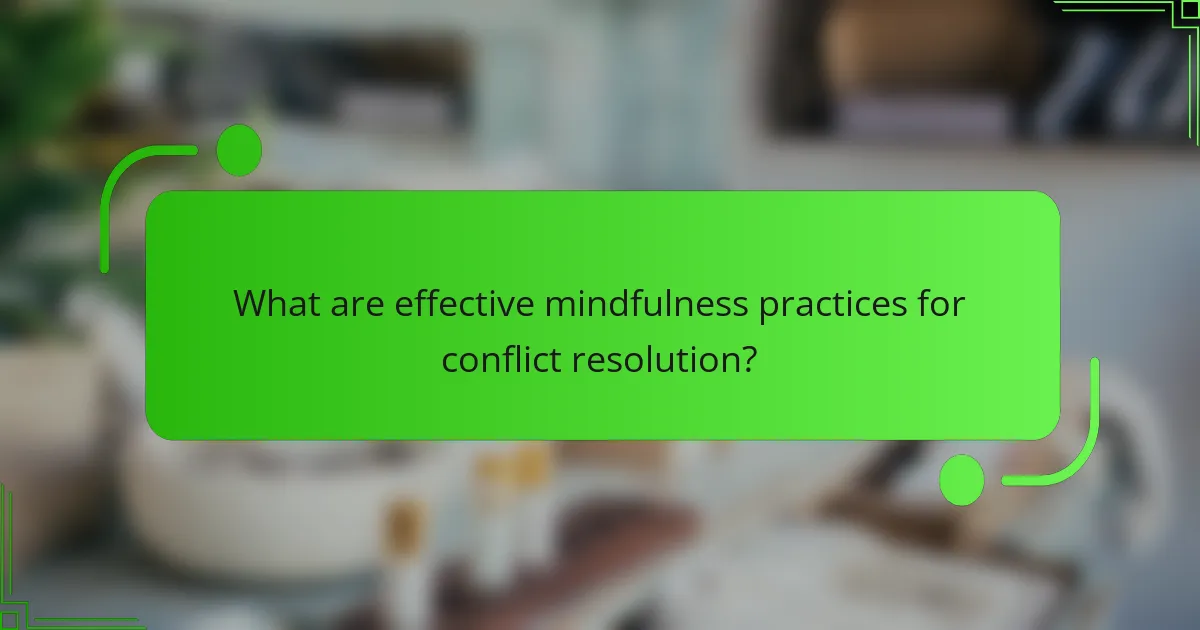
What are effective mindfulness practices for conflict resolution?
Effective mindfulness practices for conflict resolution involve techniques that enhance self-awareness and emotional regulation, enabling individuals to navigate disagreements constructively. These practices foster a calm and open mindset, allowing for clearer communication and better understanding during conflicts.
Mindfulness meditation techniques
Mindfulness meditation techniques focus on cultivating present-moment awareness, which can significantly aid in conflict resolution. Simple practices include sitting quietly and observing thoughts without judgment, or using guided meditations specifically designed for conflict situations. Regular meditation can help individuals develop patience and empathy, essential qualities for resolving disputes.
To start, set aside 10-15 minutes daily for meditation. Use apps or online resources that offer guided sessions tailored to conflict resolution. Over time, this practice can lead to improved emotional responses during challenging conversations.
Breathing exercises for calmness
Breathing exercises are effective tools for promoting calmness during conflicts. Techniques such as deep belly breathing or the 4-7-8 method can help reduce anxiety and increase focus. By concentrating on breath, individuals can create a pause before reacting, allowing for more thoughtful responses.
For example, inhale deeply for four counts, hold for seven, and exhale slowly for eight counts. Repeat this cycle a few times to regain composure. Incorporating these exercises into daily routines can enhance overall emotional resilience.
Journaling for emotional clarity
Journaling serves as a powerful method for achieving emotional clarity, especially when dealing with conflict. Writing down thoughts and feelings can help individuals process their emotions and identify underlying issues that contribute to disagreements. This practice encourages reflection and can lead to more constructive dialogues.
Consider setting aside 10-20 minutes each day to write about recent conflicts, focusing on feelings, triggers, and desired outcomes. This can clarify personal perspectives and prepare individuals for future discussions.
Role-playing scenarios
Role-playing scenarios can be an effective way to practice conflict resolution skills in a safe environment. By simulating potential conflicts with a partner or group, individuals can explore different perspectives and responses. This technique builds confidence and enhances communication skills.
To implement role-playing, choose a specific conflict scenario and take turns acting out each role. Discuss the outcomes and feelings experienced during the exercise. This practice can help identify effective strategies and improve emotional responses in real-life situations.
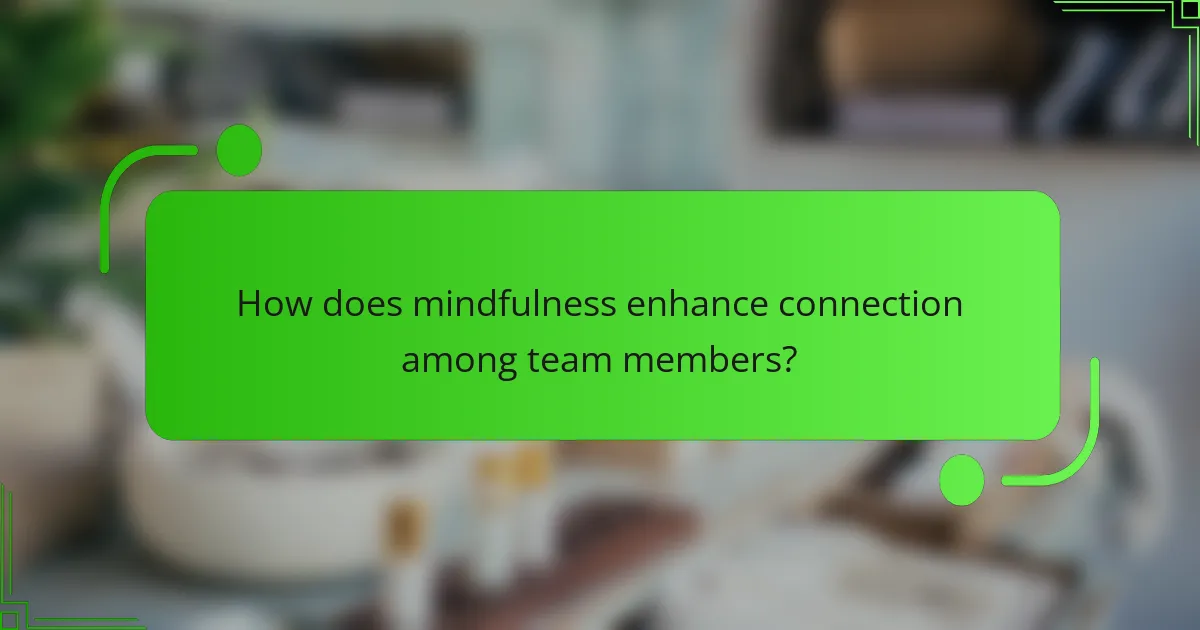
How does mindfulness enhance connection among team members?
Mindfulness enhances connection among team members by fostering awareness, empathy, and open communication. This practice encourages individuals to be present, actively listen, and respond thoughtfully, which strengthens interpersonal relationships and collaboration.
Team-building mindfulness activities
Engaging in team-building mindfulness activities can significantly improve connection among team members. Activities such as guided meditation sessions, mindful walking, or breathing exercises promote relaxation and enhance focus. These practices help individuals to connect on a deeper level, fostering trust and understanding.
Consider incorporating short mindfulness breaks during team events or meetings. Even a few minutes of collective deep breathing can create a shared sense of calm and unity, making it easier for team members to communicate effectively.
Mindful meetings structure
Structuring meetings with mindfulness in mind can lead to more productive and connected discussions. Start meetings with a brief mindfulness exercise, such as a moment of silence or a few deep breaths, to center everyone’s attention. This practice helps participants to focus and engage more fully in the conversation.
Establish clear guidelines for communication during meetings, such as encouraging active listening and minimizing distractions. This creates an environment where team members feel valued and heard, enhancing overall connection.
Shared mindfulness experiences
Creating opportunities for shared mindfulness experiences can deepen connections among team members. Organize regular group mindfulness sessions, such as yoga classes or meditation workshops, to foster a sense of community and shared purpose. These experiences allow individuals to bond over common practices and enhance their emotional connections.
Encourage team members to share their mindfulness journeys and insights with one another. This exchange of personal experiences can lead to greater empathy and understanding, further strengthening team dynamics and collaboration.
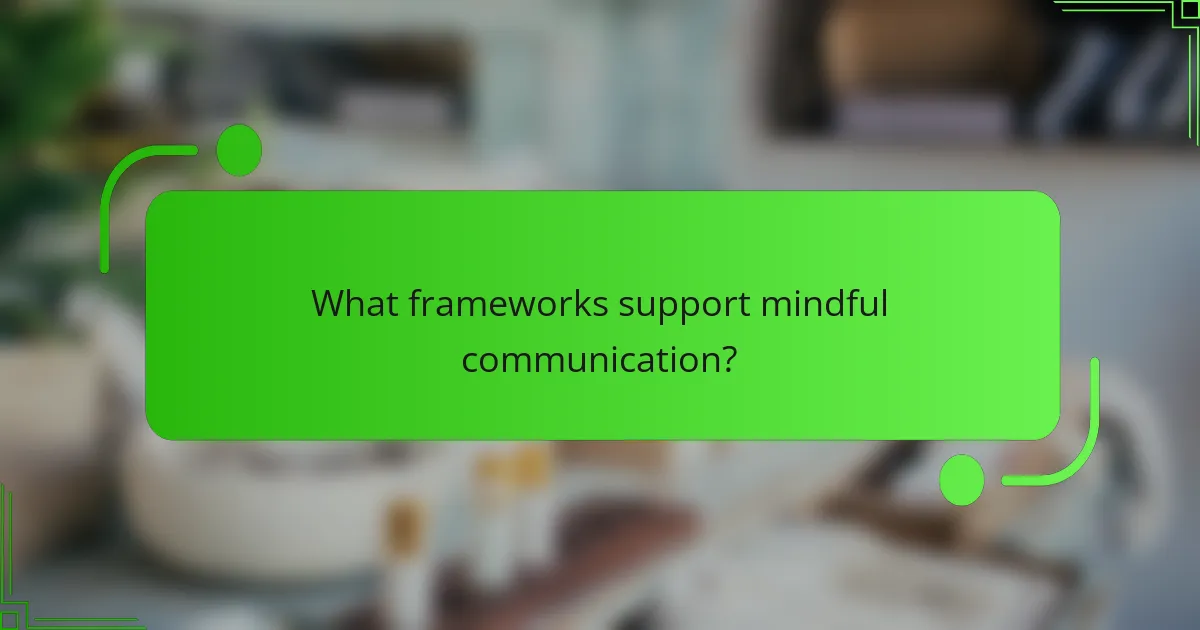
What frameworks support mindful communication?
Mindful communication is supported by frameworks that emphasize empathy, clarity, and connection. Two prominent models are Nonviolent Communication and Mindful Leadership principles, which provide structured approaches to enhance interpersonal interactions and resolve conflicts effectively.
Nonviolent Communication model
The Nonviolent Communication (NVC) model, developed by Marshall Rosenberg, focuses on expressing feelings and needs without judgment. It encourages individuals to observe situations objectively, articulate their emotions, and request specific actions that would meet their needs.
Key components of NVC include four steps: observation, feeling, need, and request. For example, instead of saying, “You never listen to me,” one might say, “When I speak and I don’t feel heard, I feel frustrated because I need connection. Would you be willing to listen more attentively?”
To practice NVC effectively, avoid blaming language, focus on your own experiences, and be open to feedback. This approach fosters a collaborative atmosphere and reduces defensiveness in conversations.
Mindful Leadership principles
Mindful Leadership principles emphasize self-awareness, presence, and compassion in leadership roles. Leaders who practice mindfulness are better equipped to handle conflicts, inspire their teams, and create a supportive work environment.
Key aspects of mindful leadership include active listening, maintaining emotional regulation, and fostering a culture of openness. For instance, a mindful leader may take a moment to breathe and reflect before responding to a team member’s concern, ensuring their response is thoughtful and constructive.
To implement mindful leadership, prioritize regular mindfulness practices such as meditation or reflective journaling. Encourage team members to share their thoughts and feelings, creating a space where everyone feels valued and understood. This approach can significantly enhance team cohesion and productivity.

How can mindfulness be integrated into workplace culture?
Integrating mindfulness into workplace culture involves fostering an environment that encourages awareness, presence, and emotional intelligence among employees. This can lead to improved communication, stronger connections, and effective conflict resolution.
Workplace mindfulness programs
Workplace mindfulness programs are structured initiatives designed to promote mindfulness practices among employees. These programs can include daily meditation sessions, mindfulness breaks, or dedicated quiet spaces for reflection. Companies often see benefits such as reduced stress levels and increased productivity.
To implement a successful program, consider starting with short, guided sessions that last around 10-15 minutes. Gradually increase the duration and frequency as employees become more comfortable with the practice. Regular feedback can help tailor the program to meet the specific needs of your workforce.
Mindfulness training workshops
Mindfulness training workshops provide employees with the skills and techniques to practice mindfulness effectively. These workshops can cover topics such as breathing exercises, mindful listening, and emotional regulation strategies. Engaging an experienced facilitator can enhance the learning experience.
Workshops typically range from half-day to full-day sessions, allowing for immersive learning. It’s beneficial to incorporate interactive elements, such as group discussions or role-playing scenarios, to reinforce the concepts. Follow-up sessions can help maintain momentum and encourage ongoing practice.

What are the benefits of mindfulness in conflict resolution?
Mindfulness in conflict resolution enhances communication and fosters a deeper understanding between parties. By promoting awareness and presence, it helps individuals manage their reactions and approach disputes with clarity and empathy.
Improved emotional regulation
Mindfulness practices encourage individuals to observe their emotions without immediate reaction, leading to better emotional regulation during conflicts. This self-awareness allows people to pause and choose responses rather than react impulsively, which can escalate tensions.
For example, taking a few deep breaths before responding in a heated discussion can help lower stress levels and provide clarity. Techniques such as meditation or focused breathing can be practiced regularly to strengthen this skill over time.
Enhanced problem-solving skills
Mindfulness fosters a more open mindset, which is crucial for effective problem-solving in conflicts. By being present and attentive, individuals can better identify the root causes of issues and explore creative solutions collaboratively.
Engaging in active listening, where one fully concentrates on the speaker without planning a response, can lead to more productive discussions. Additionally, brainstorming sessions that incorporate mindfulness techniques can encourage diverse perspectives and innovative ideas.
